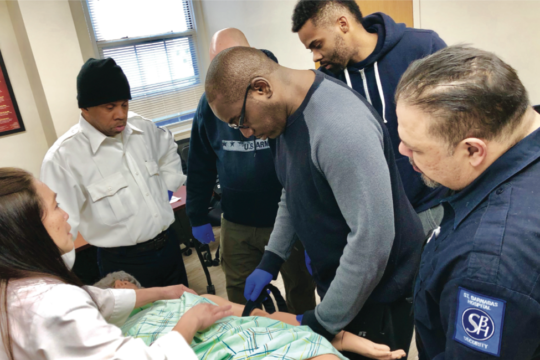
This is a program that is intended to stabilize a patient with an open wound until First Responders arrive.
This is the final slide in the “Stop the Bleed” presentation of Erik Marketan, SBH’s injury prevention coordinator and one of the course’s certified instructors. While not nearly as disturbing as the graphic photos of severe open wounds, it is the slide that perhaps resonates most with the group of a dozen or so SBH security officers and CUNY School of Medicine students taking the 90-minute lecture/hands-on class that will soon be available to all SBH employees as a “lunch and learn.” Earlier classes have been attended by surgery residents, nurses and various community groups, including the staff of B.R.A.G. (Bronx Rises Against Gun Violence), the hospital’s “cure violence” partner.
“This is an American College of Surgeons (ACS) Injury Prevention initiative that comes as a result of ‘The Hartford Consensus,’ which has continued to bring together leaders from the medical community, the federal government and first responder agencies to discuss lessons earned, conduct research and make recommendations resulting from both the active shooter disaster at Sandy Hook Elementary School in Newtown, Connecticut and the Boston Marathon bombing,” says Marketan, who spent 20 years as a New York City paramedic. “In Boston, the immediate presence of first responders and the use of tourniquets became a perfect storm of survival that led to most of the victims (many with below-the-knee and near amputations) surviving, whereas in many situations artery ruptures like this would cause victims to go into shock and perhaps not survive to the ER and OR. So there was a revisiting of what tourniquets can do and the role they play in trauma care.”
A curriculum has been created, says Marketan, which is very “digestible” for the lay rescuer and for the healthcare practitioner to become certified as an instructor. “If I train you today (as a lay rescuer) and you were to be, let’s say, in an airport in five years and something were to occur, such as somebody falling through a plate of glass, you could say ‘I remember direct pressure, how to strap on a tourniquet and turn it, or how to pack a wound.’ It’s very intuitive. There’s not a lot of complex task and skill memory.”
“Stop the Bleed” shows how to control life-threatening bleeding while waiting for first responders to arrive. This, says Marketan, can be beneficial in the case of work-related or home injuries or motor vehicle accidents – not just bombings or mass shootings.
The class learns the “ABCs of bleeds” – alert 911, find the bleeding injury, compress (apply pressure to stop the bleeding). Marketan explains the differences between arterial bleeding and venous bleeding and recognition when a tourniquet is the immediate “go to.” For a severe bleeding injury to a limb, he teaches how to administer a Combat Application Tourniquet (an easy-to-use, well-designed strap with Velcro, a windlass stick to tighten, and a notch to keep the tourniquet in place, that is accompanied in the “Stop the Bleed” kit with such other essentials as disposable gloves; compression bandages; hemostatic gauze, with agents that help in clotting; and even a Sharpie – to write such things as time placed and “TK” on the victim’s forehead, indicating to emergency personnel the use of a tourniquet on the victim).
“Once you identify the wound, place the tourniquet several inches above the injury (or above, not on, a joint, such as an elbow or knee) and turn the tourniquet windlass to the right until bleeding stops,” he says. “Don’t loosen it if the victim says it hurts. It should hurt. No one will fault you for being too aggressive with a tourniquet. In some cases, patients go to the OR with a tourniquet on.”
He demonstrates how gauze or a cloth needs to be applied with pressure to a bleeding wound located on the victim’s torso, head, abdomen or groin, where a tourniquet could not be applied. The class takes turns applying the tourniquets and maintaining continuous pressure to the mannequin and the simulated “arm,” and packing the “wound” with gauze (“like kneading dough with your fingers”) using a simulation wound skin pack.
Marketan brings with him years of training as an educator as well as a critical care paramedic. He has been additionally trained in CBRN (Chemical,Biological, Radiological and Nuclear) and has worked as an external provider through the United Nations with the Organization for the Prohibition of Chemical Weapons (OPCW), based in The Netherlands, where he provided medical training for teams deployed around the world.
Of course, as he notes, disasters happen when they are least expected and so lay personnel are not always going to have “Stop the Bleed” kits at their beck and call (although there are recommendations for having such kits in easy-to-access hospital locations and with security, as there are now for fire extinguishers and defibrillators). This is why he spends time discussing makeshift tools for stopping the bleeding. This can include tying a cloth, a roll of gauze, or a necktie and using pens, knives or a small flashlight to use as a tourniquet to stench the bleeding. The class learns that a cloth with a thin layer of cotton (e.g. an undershirt) works more effectively than a towel with heavy absorbing material; and that a belt should be employed only as a last resort for a tourniquet (which can’t be tightened enough to compress the arteries).
Minutes, says Marketan, can be the difference between life and death. “If someone is losing blood, single minutes of that blood loss can be fatal,” he says. “What we’re doing is buying a victim enough time until a trained medical professional arrives.”
 GIVING
GIVING (718) 960-9000
(718) 960-9000